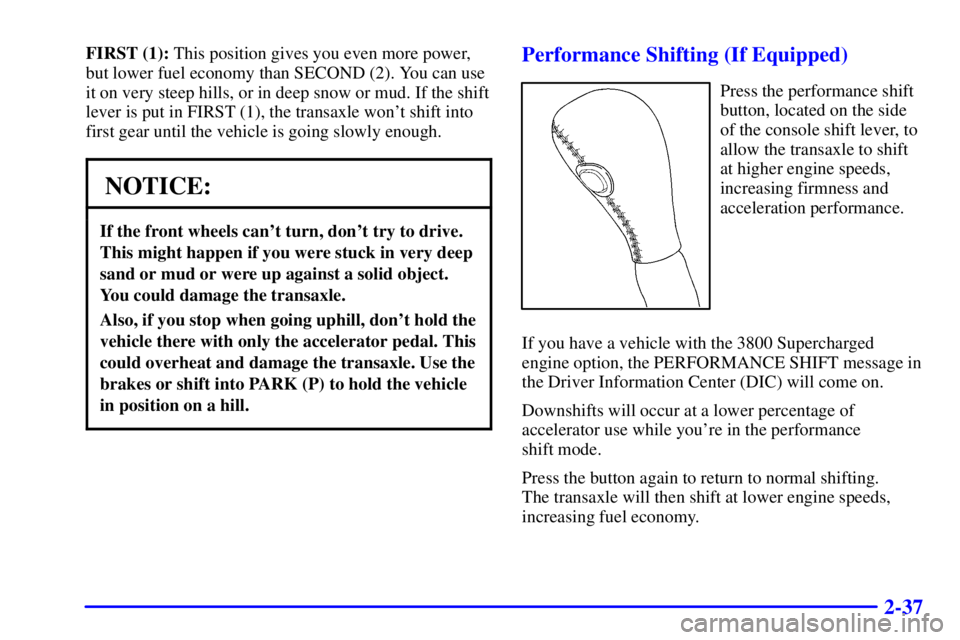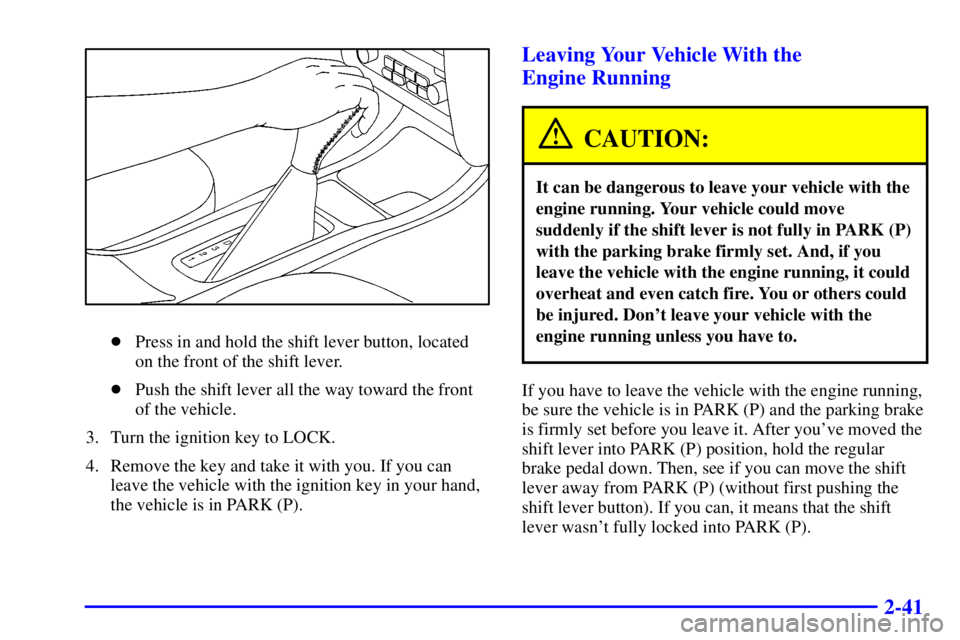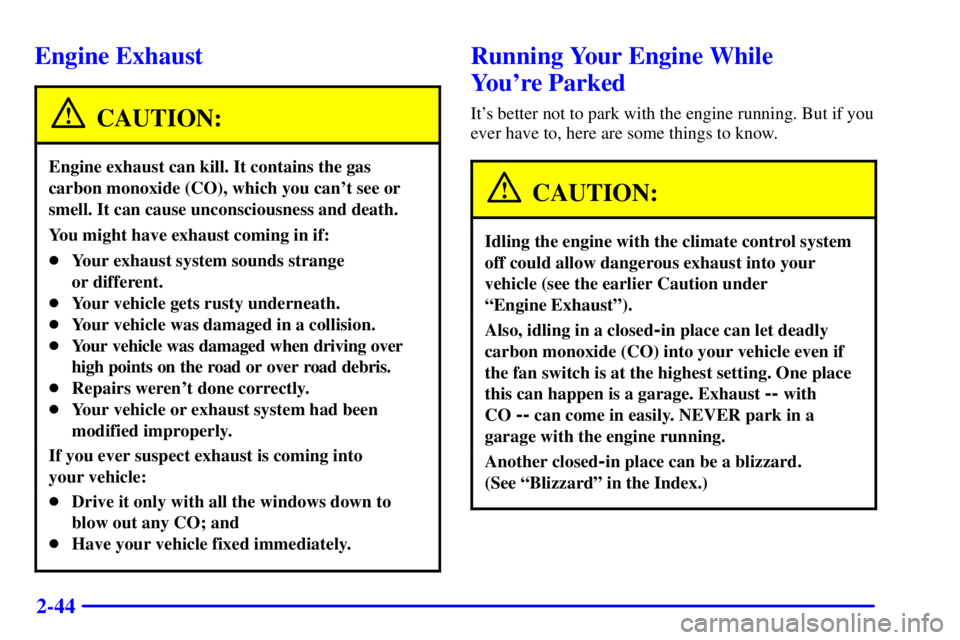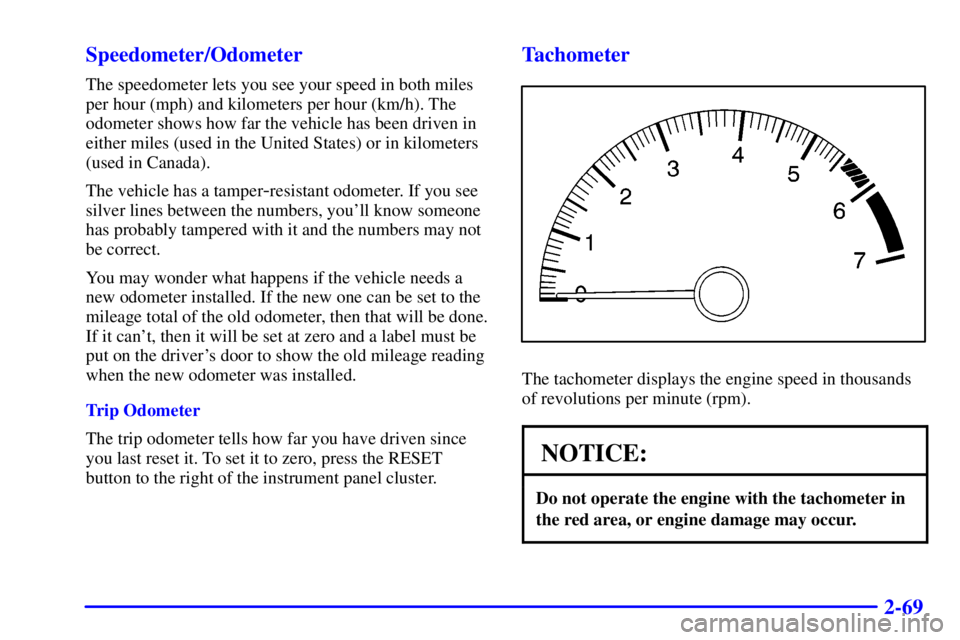Page 104 of 376

2-36
AUTOMATIC OVERDRIVE (D): This position is for
normal driving. If you need more power for passing,
and you're:
�Going less than 35 mph (55 km/h), push the
accelerator pedal about halfway down.
�Going about 35 mph (55 km/h) or more, push the
accelerator pedal all the way down.
You'll shift down to the next gear and have more power.
NOTICE:
If the vehicle seems to start up rather slowly,
or if it seems not to shift gears as you go faster,
something may be wrong with a transaxle system
sensor. If you drive very far that way, the vehicle
can be damaged. So, if this happens, have the
vehicle serviced right away. Until then, you can
use SECOND (2) when you are driving less than
35 mph (55 km/h) and AUTOMATIC
OVERDRIVE (D) for higher speeds.
THIRD (3): This position is also used for normal
driving, but it offers more power and lower fuel
economy than AUTOMATIC OVERDRIVE (D).Here are some times you might choose THIRD (3)
instead of AUTOMATIC OVERDRIVE (D):
�When driving on hilly, winding roads.
�When towing a trailer, so there is less shifting
between gears.
�When going down a steep hill.
SECOND (2): This position gives you more power,
but lower fuel economy than THIRD (3). You can use
SECOND (2) on hills. It can help control your speed as
you go down steep mountain roads, but then you would
also want to use the brakes off and on.
NOTICE:
Don't drive in SECOND (2) for more than
25 miles (40 km) at speeds over 55 mph
(88 km/h), or you can damage the transaxle.
Use AUTOMATIC OVERDRIVE (D) or
THIRD (3) as much as possible.
Don't shift into SECOND (2) unless you are going
slower than 65 mph (105 km/h), or you can
damage the engine.
Page 105 of 376

2-37
FIRST (1): This position gives you even more power,
but lower fuel economy than SECOND (2). You can use
it on very steep hills, or in deep snow or mud. If the shift
lever is put in FIRST (1), the transaxle won't shift into
first gear until the vehicle is going slowly enough.
NOTICE:
If the front wheels can't turn, don't try to drive.
This might happen if you were stuck in very deep
sand or mud or were up against a solid object.
You could damage the transaxle.
Also, if you stop when going uphill, don't hold the
vehicle there with only the accelerator pedal. This
could overheat and damage the transaxle. Use the
brakes or shift into PARK (P) to hold the vehicle
in position on a hill.
Performance Shifting (If Equipped)
Press the performance shift
button, located on the side
of the console shift lever, to
allow the transaxle to shift
at higher engine speeds,
increasing firmness and
acceleration performance.
If you have a vehicle with the 3800 Supercharged
engine option, the PERFORMANCE SHIFT message in
the Driver Information Center (DIC) will come on.
Downshifts will occur at a lower percentage of
accelerator use while you're in the performance
shift mode.
Press the button again to return to normal shifting.
The transaxle will then shift at lower engine speeds,
increasing fuel economy.
Page 108 of 376
2-40
NOTICE:
Driving with the parking brake on can cause the
rear brakes to overheat. You may have to replace
them, and you could also damage other parts of
the vehicle.
If you are towing a trailer and parking on a hill, see
ªTowing a Trailerº in the Index. That section shows
what to do first to keep the trailer from moving.
Shifting Into PARK (P)
CAUTION:
It can be dangerous to get out of your vehicle if
the shift lever is not fully in PARK (P) with the
parking brake firmly set. Your vehicle can roll.
If you have left the engine running, the vehicle
can move suddenly. You or others could be
injured. To be sure your vehicle won't move, even
when you're on fairly level ground, use the steps
that follow. If you're pulling a trailer, see
ªTowing a Trailerº in the Index.
1. Hold the brake pedal down with your right foot and
set the parking brake.
2. Move the shift lever into PARK (P) position
like this:
Page 109 of 376

2-41
�Press in and hold the shift lever button, located
on the front of the shift lever.
�Push the shift lever all the way toward the front
of the vehicle.
3. Turn the ignition key to LOCK.
4. Remove the key and take it with you. If you can
leave the vehicle with the ignition key in your hand,
the vehicle is in PARK (P).
Leaving Your Vehicle With the
Engine Running
CAUTION:
It can be dangerous to leave your vehicle with the
engine running. Your vehicle could move
suddenly if the shift lever is not fully in PARK (P)
with the parking brake firmly set. And, if you
leave the vehicle with the engine running, it could
overheat and even catch fire. You or others could
be injured. Don't leave your vehicle with the
engine running unless you have to.
If you have to leave the vehicle with the engine running,
be sure the vehicle is in PARK (P) and the parking brake
is firmly set before you leave it. After you've moved the
shift lever into PARK (P) position, hold the regular
brake pedal down. Then, see if you can move the shift
lever away from PARK (P) (without first pushing the
shift lever button). If you can, it means that the shift
lever wasn't fully locked into PARK (P).
Page 112 of 376

2-44
Engine Exhaust
CAUTION:
Engine exhaust can kill. It contains the gas
carbon monoxide (CO), which you can't see or
smell. It can cause unconsciousness and death.
You might have exhaust coming in if:
�Your exhaust system sounds strange
or different.
�Your vehicle gets rusty underneath.
�Your vehicle was damaged in a collision.
�Your vehicle was damaged when driving over
high points on the road or over road debris.
�Repairs weren't done correctly.
�Your vehicle or exhaust system had been
modified improperly.
If you ever suspect exhaust is coming into
your vehicle:
�Drive it only with all the windows down to
blow out any CO; and
�Have your vehicle fixed immediately.
Running Your Engine While
You're Parked
It's better not to park with the engine running. But if you
ever have to, here are some things to know.
CAUTION:
Idling the engine with the climate control system
off could allow dangerous exhaust into your
vehicle (see the earlier Caution under
ªEngine Exhaustº).
Also, idling in a closed-in place can let deadly
carbon monoxide (CO) into your vehicle even if
the fan switch is at the highest setting. One place
this can happen is a garage. Exhaust
-- with
CO
-- can come in easily. NEVER park in a
garage with the engine running.
Another closed-in place can be a blizzard.
(See ªBlizzardº in the Index.)
Page 113 of 376
2-45
CAUTION:
It can be dangerous to get out of your vehicle if
the shift lever is not fully in PARK (P) with the
parking brake firmly set. Your vehicle can roll.
Don't leave your vehicle when the engine is
running unless you have to. If you've left the
engine running, the vehicle can move suddenly.
You or others could be injured. To be sure your
vehicle won't move, even when you're on fairly
level ground, always set your parking brake and
move the shift lever to PARK (P).
Follow the proper steps to be sure your vehicle won't
move. See ªShifting Into PARK (P)º in the Index.
If you are parking on a hill and if you're pulling a
trailer, also see ªTowing a Trailerº in the Index.
Power Windows
Switches on the driver's door armrest operate each of
the windows when the ignition or retained accessory
power (RAP) is active. See ªRetained Accessory Power
(RAP)º in the Index. In addition, each passenger door
has its own window switch.
Page 118 of 376

2-50
If your vehicle is in cruise control when the traction
control system on the 3800 Supercharged V6 engine
or the enhanced traction system on the 3100 V6 and
3800 V6 engine begins to limit wheel spin, the cruise
control will automatically disengage. (See ªTraction
Control Systemº or ªEnhanced Traction Systemº in the
Index.) When road conditions allow you to safely use it
again, you may turn the cruise control back on.
Setting Cruise Control
CAUTION:
If you leave your cruise control switch on when
you're not using cruise, you might hit a button
and go into cruise when you don't want to. You
could be startled and even lose control. Keep the
cruise control switch off until you want to use
cruise control.
1. Move the cruise control switch to ON.
2. Get up to the speed you want.
3. Push in the SET button at the end of the lever and
release it.
4. Take your foot off the accelerator pedal.
Resuming a Set Speed
Suppose you set the cruise control at a desired speed and
then you apply the brake. This, of course, shuts off the
cruise control. But you don't need to reset it.
Once you're going about 25 mph (40 km/h) or more
again, you can move the cruise control switch from
ON to R/A (Resume/Accelerate) briefly. You'll go right
back up to your chosen speed and stay there.
Page 137 of 376

2-69 Speedometer/Odometer
The speedometer lets you see your speed in both miles
per hour (mph) and kilometers per hour (km/h). The
odometer shows how far the vehicle has been driven in
either miles (used in the United States) or in kilometers
(used in Canada).
The vehicle has a tamper
-resistant odometer. If you see
silver lines between the numbers, you'll know someone
has probably tampered with it and the numbers may not
be correct.
You may wonder what happens if the vehicle needs a
new odometer installed. If the new one can be set to the
mileage total of the old odometer, then that will be done.
If it can't, then it will be set at zero and a label must be
put on the driver's door to show the old mileage reading
when the new odometer was installed.
Trip Odometer
The trip odometer tells how far you have driven since
you last reset it. To set it to zero, press the RESET
button to the right of the instrument panel cluster.
Tachometer
The tachometer displays the engine speed in thousands
of revolutions per minute (rpm).
NOTICE:
Do not operate the engine with the tachometer in
the red area, or engine damage may occur.